This may go nowhere (and I’m too lazy to look to see if something exists), but a chance to map Cutler mailing system mail chutes and/or boxes.
Category Archives: Relics
Relics: Another Cutler mailing system lobby mailbox at National Louis University
On Friday in the late afternoon I went to the National Louis University building on Michigan Avenue for a physical therapy assessment. When I left, I was thinking mainly of how to get home, so I didn’t pay attention to my surroundings.
I returned this morning and as I was leaving this caught my eye — another Cutler mailing system lobby box for my photo collection. There was a white plastic USPS bin next to it, but I’m assuming it’s still in commission. I wonder if I could use Google Maps to map these collaboratively. Hmmm.

Pomona General Store
On a 2013 visit to Shawnee National Forest in southern Illinois, I came across this gem at a crossroads near the Pomona Natural Bridge. Finding the photos again, I was curious about what this building had been and when it closed for good.
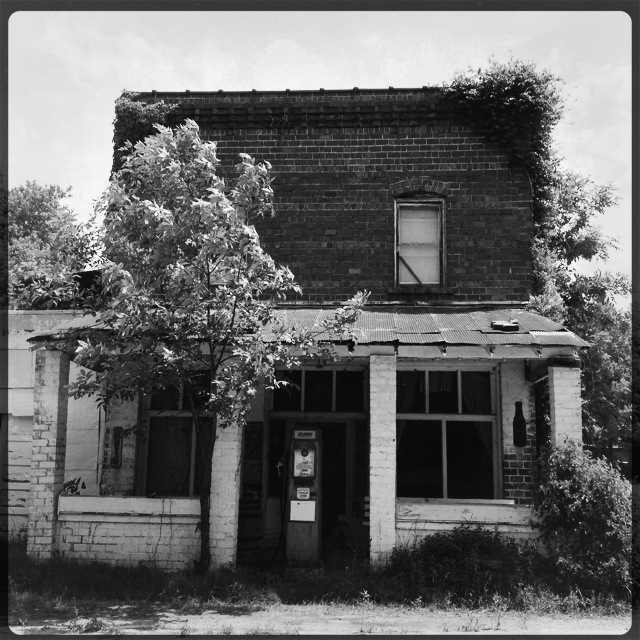
May 25, 2013

May 25, 2013

May 25, 2013
It’s the Pomona General Store, and even the New York Times published an article about it.
At an Illinois Country Store, Nostalgia Sells Best
July 15, 1987
The store was built in 1876 when Pomona, about 15 miles southwest of Carbondale near the southern tip of Illinois, was a railroad town with more than 500 residents and a shipping point for produce.The original wooden store burned down in 1915. A rebuilt store burned in 1917, and a brick store was built the same year to replace it.
I dug around newspapers.com and found a little of the store’s most recent history starting with the 1970s, when media mentions picked up. Over the next couple of decades, the store changed hands a few times. It also attracted attention as a relic — an old-school general store in an era of big box stores. For years it seemed to be a center of Pomona community. Even after it closed, its location was used for community events like bake sales.
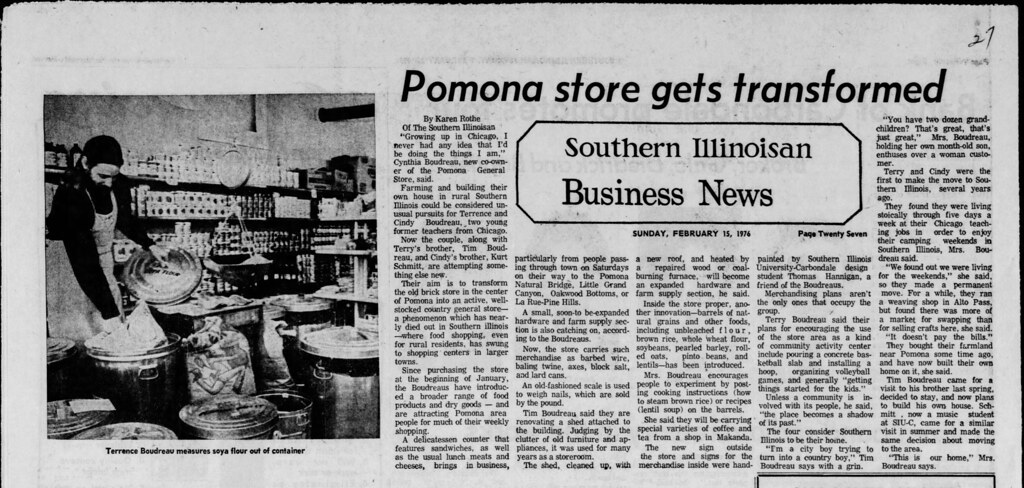

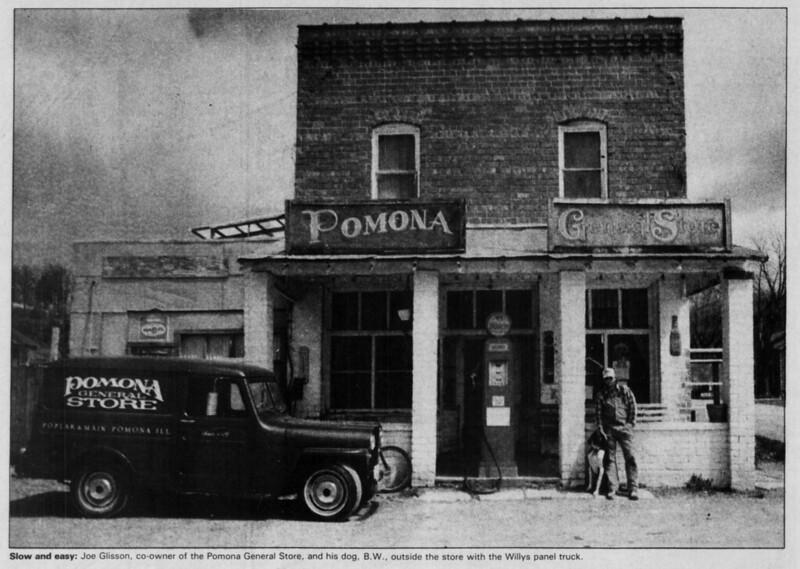
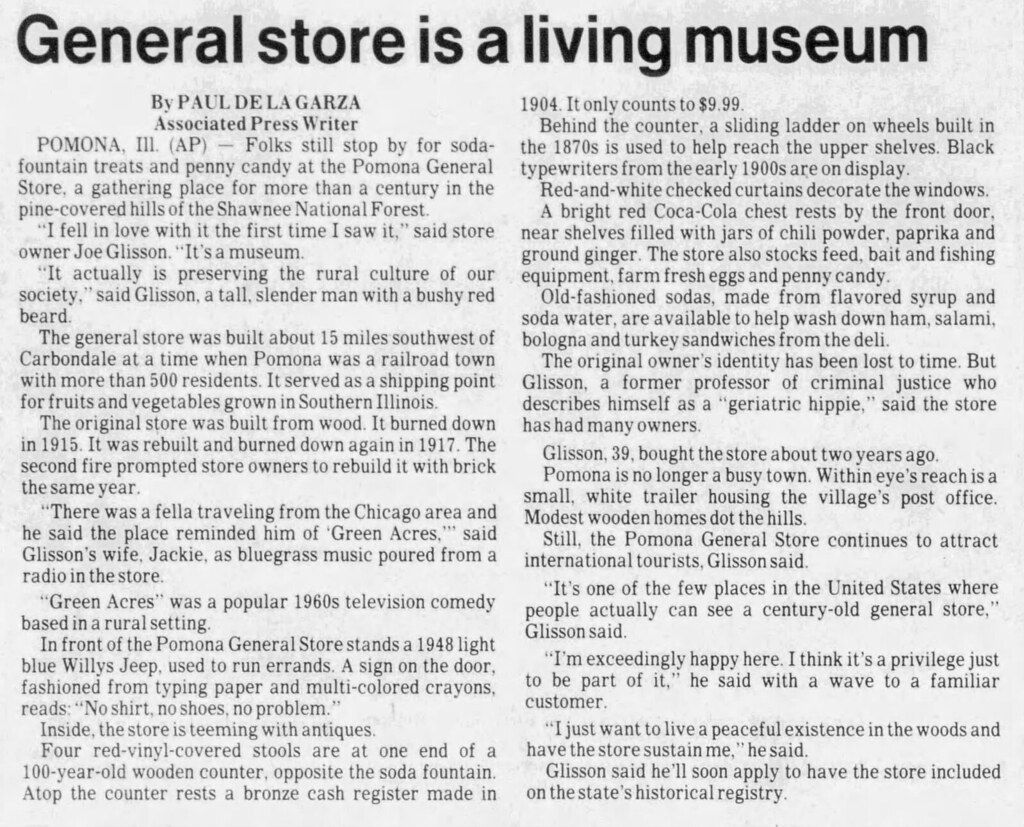
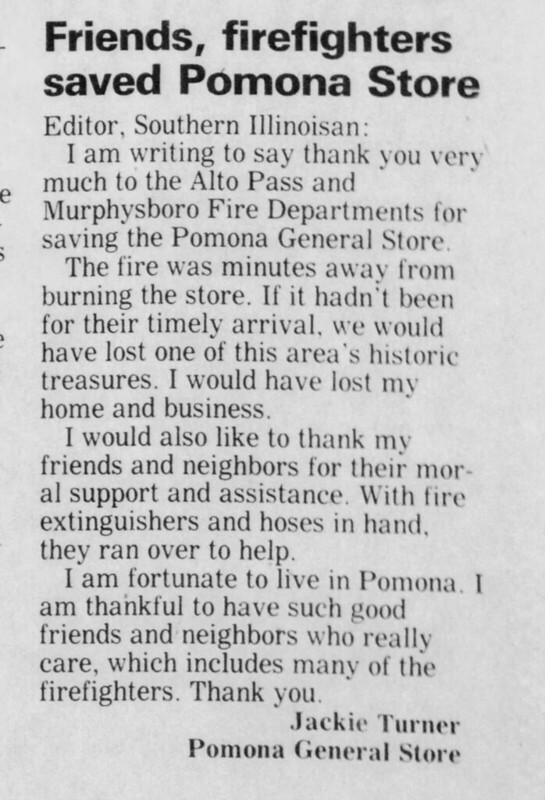
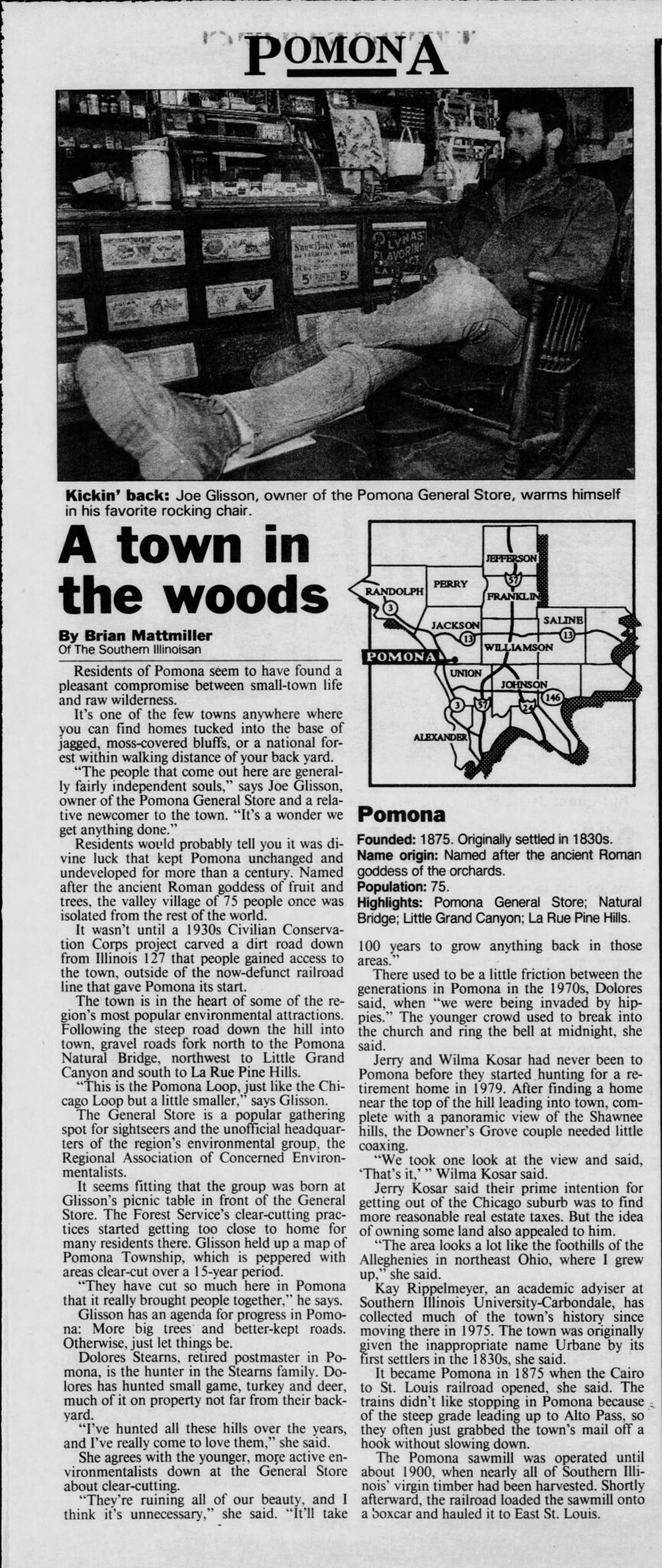
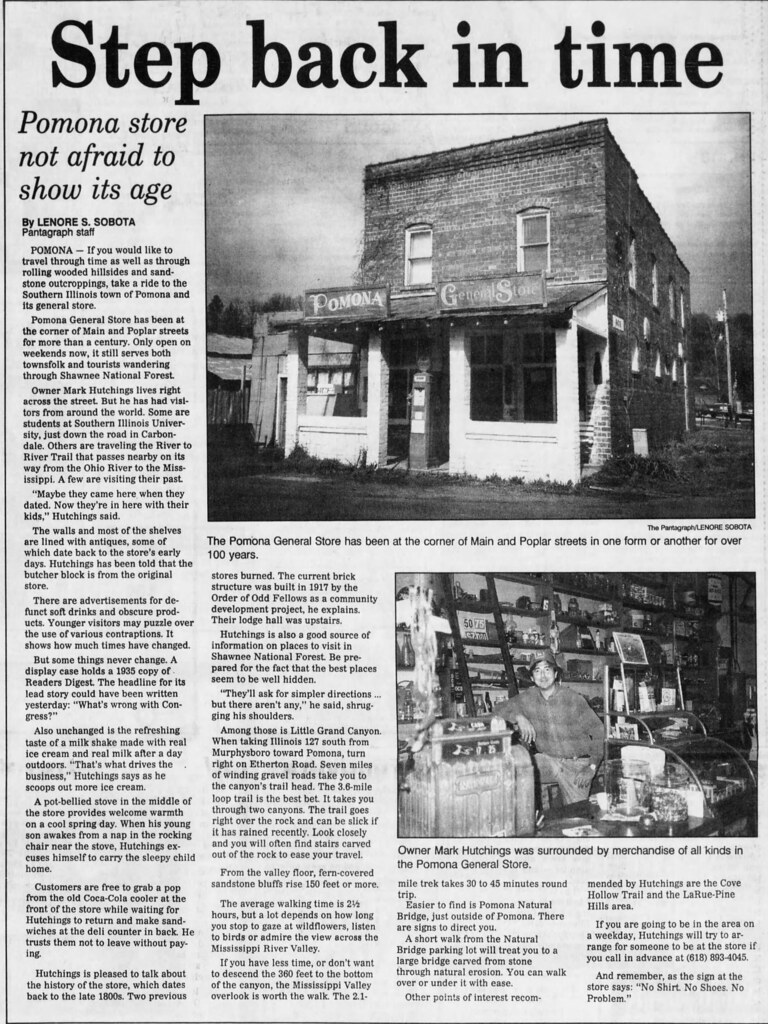
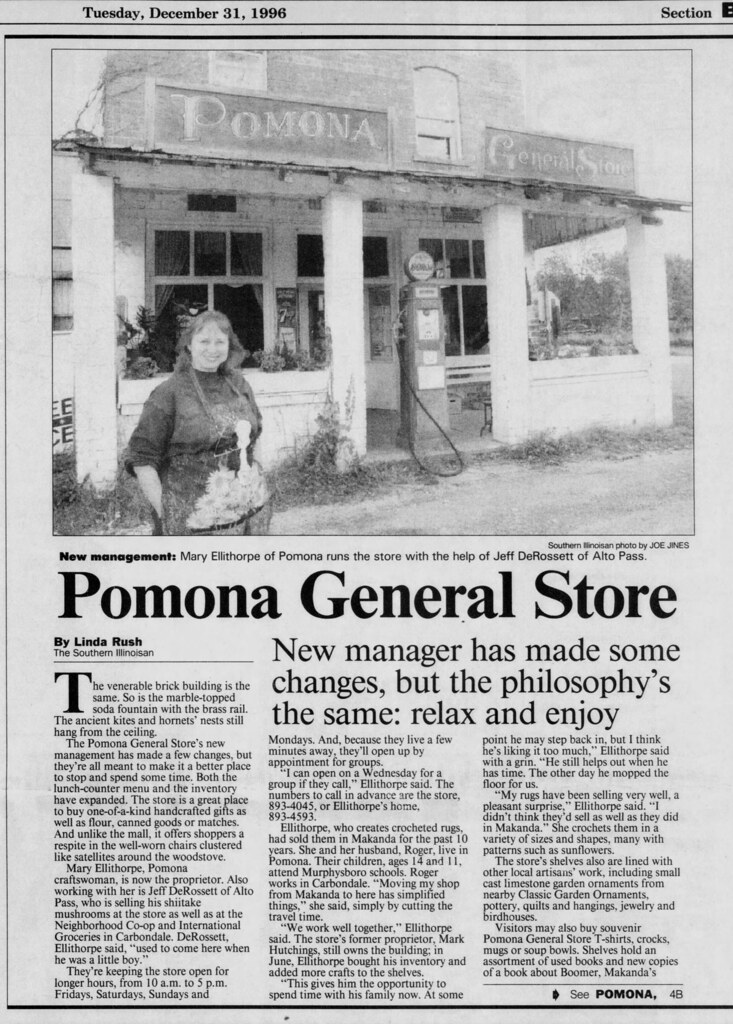
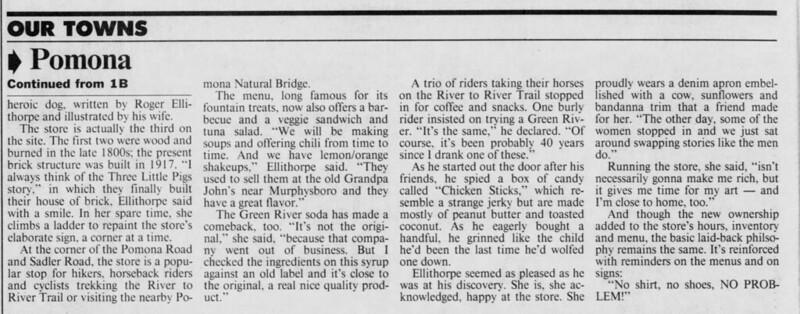
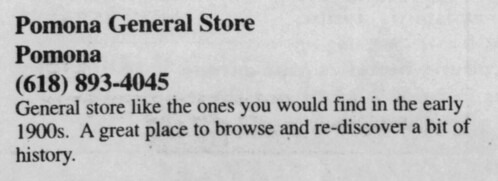
A few people have mentioned surprise the gas pump was in place (as of 2013) as they are “very collectible.” I found a photo from 2022 that shows the pump still there. Perhaps the Pomona community keeps a watchful eye on it.
The store must have closed between 2000 and 2002. Over the next decade or so, it deteriorated more than I would have expected. I’m reminded of what I saw of the TV series “Life After People,” which speculated how plants, wildlife, and other forces would eat away at the infrastructure and buildings humans have wrought after they were no longer maintained.
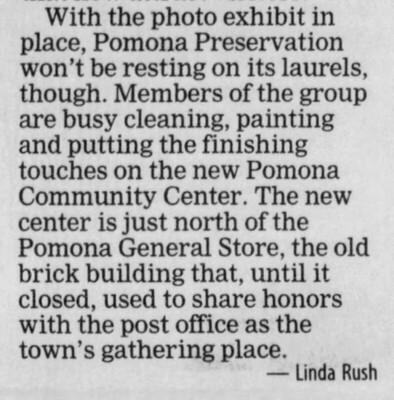
I imagine someday in Pomona the ivy will finally take over the store, and time will erase the memories.
Updated 12/28/2024: On Instagram, an exterior from 1982. The red gas pump is visible.
RANI incense cones
Both my parents were born during the 19-teens and weren’t what you’d call “hippies.” We had something associated with hippies, though — incense. RANI incense cones, to be precise, usually pine. Gift? Sale? I don’t know, but my mother liked them even if we used them sparingly. I’ve continued the tradition, buying incense (if not RANI) sporadically over the years.
Something made me think of RANI, so I looked up images of the box and found RANI, marketed as “house deodorant,” came from Chicago 60616. According to the trademark database the Hindu Incense Manufacturing Co. , Inc., was located at 2620 South Dearborn St. Office? Factory? I may never know. Sadly, today it’s a vacant lot. You can sometimes find the remaining boxes for sale on sites like eBay and Etsy.


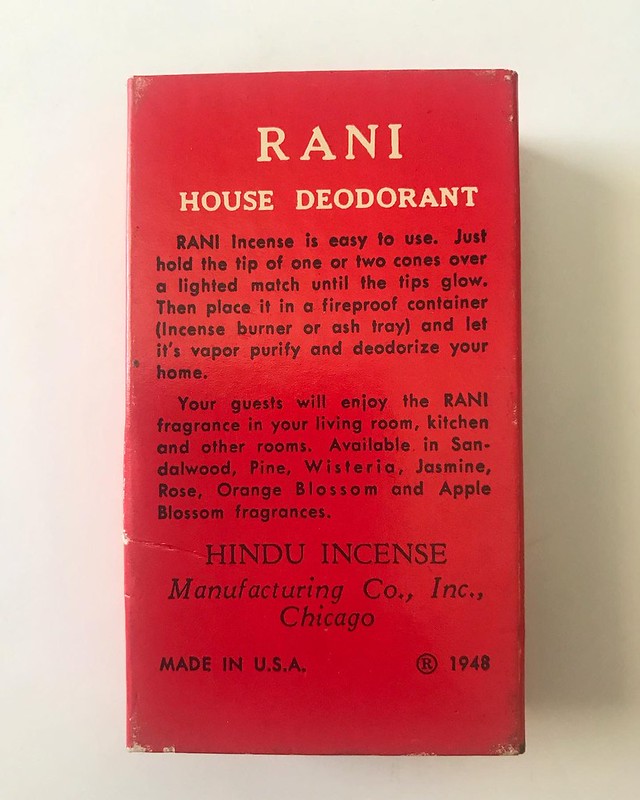
More about the RANI mark:
Word Mark RANI
Goods and Services (EXPIRED) IC 003. US 006. G & S: INCENSE. FIRST USE: 19270415. FIRST USE IN COMMERCE: 19270810
Mark Drawing Code (5) WORDS, LETTERS, AND/OR NUMBERS IN STYLIZED FORM
Serial Number 71527404
Filing Date July 5, 1947
Current Basis 1A
Original Filing Basis 1A
Registration Number 0500209
Registration Date May 11, 1948
Owner (REGISTRANT) HINDU INCENSE MANUFACTURING CO. CORPORATION ILLINOIS 2620 SOUTH DEARBORN ST. CHICAGO ILLINOIS
(LAST LISTED OWNER) GENIECO, INC. CORPORATION BY CHANGE OF NAME FROM ILLINOIS 200 NORTH LAFLIN ST. CHICAGO ILLINOIS 60607Assignment Recorded ASSIGNMENT RECORDED
Type of Mark TRADEMARK
Register PRINCIPAL
Affidavit Text SECT 15.
Renewal 2ND RENEWAL 19880511
Live/Dead Indicator DEAD
Genieco lead me to the current Gonesh brand website, from which I learned:
In 1923, a Lithuanian immigrant named Radzukinas acquired a small company, The Hindu Incense Company. For business purposes, he changed his name to Radkins and changed the fortune of his small company by dedicating himself to the manufacture of quality charcoal incense cones and incense burners. Laurent Radkins operated the Hindu Incense Company successfully from the 1920s to the 1960s.
In the mid-sixties, the second generation of the Radkins family entered the business and Genieco, Inc. was born. Soon, the product offering was expanded to include incense sticks. The new brand name was GONESH®, named after the Hindu Elephant Boy, the God of Luck. The name Gonesh was trademarked in 1965.
The Chicago-based Hindu Incense Manufacturing Co., Inc., owned and run by a Lithuanian immigrant, marketing made-in-U.S.A. “house deodorant” incense cones to Greatest Generation housewives — a very American American dream.
Relics: Laundromat

According to the Hyde Park Herald, Hyde Parkers who don’t have laundry facilities in their house or building now have to go outside the neighborhood for clean clothes.
Harper & 53rd Launder Koin, the last laundromat in Hyde Park, is closing for good on Tuesday.
The property, located at 5230 S. Harper Ave., is being purchased by the University of Chicago. According to co-owner Josh Hwang, Launder Koin’s last day in operation is technically Feb. 28, but “residents should try and get their laundry done before Feb. 26.”
The laundromat has been operating off 53rd Street since 2002, predating large nearby developments like Harper Court. Back then, Hwang was only 13 years old and working at the business for his parents.
Though demand for laundromats has dwindled nationwide in the last decade, Hwang said Launder Koin still services between 500 to 1,200 people a month.
I’ve wondered if I should do a “Relics” post on the institution of the laundromat, but it never seemed to be the right time. After seeing this article in the Hyde Park Herald, I figure the right time is now. The laundromat is on its way to becoming a relic, and may be for many years.
I grew up in a trailer — no dishwasher, no washer, no dryer. My understanding is in the trailer park’s early days the women did the laundry in the building “down front” (the entrance from Rte. 20). There may have been an informal “laundry day” (Tuesday? Wednesday?). The building was shut up by the time I was old enough to peer through its grimy windows and appeared to be junk storage.
Later, my dad, the only licensed driver, took the laundry to a laundromat on South Lake Park Avenue (6000? 6150?) in Hamburg on Saturdays, mostly by himself. I think it was on one occasion when I went with him that a woman asked him, with his shock of almost snow-white hair, about his cute granddaughter. “That’s my daughter,” he corrected her. I’m sure the women at the laundromat looked at him with newfound respect after that.
Winter trips took longer because he had to dry everything at the laundromat. I tried to dry jeans once or twice in winter air, but discovered they could break (tear) when frozen.
In finer weather, the wet clothes and sheets came home so we could hang them on the clotheslines. After a few hours in the breeze, they really did smell great. They also could pick up bird droppings, stains from falling wild cherries, or, worst of all, in late spring, tent caterpillars. Around May a plague of them would infest the cherry trees over the trailer and clotheslines. You hoped to pick them off so you wouldn’t find any, or parts of any, on your clothes or bedclothes later.
I imagine the laundromat could be a social place, with regulars on Saturday morning who exchanged greetings and maybe chat — with no phones or devices to distract them. Of course, you could always step out and go to a nearby store. It wasn’t likely at that time your clothes would go missing.
After I came to the university, I didn’t need to use a laundromat. The dormitory had washers and dryers, and my apartments since have had on-site laundry machines. The first was tough — I lived on the fourth floor, and the machines were on the first. There weren’t enough, so I could go down and up the stairs several times before one was free. It used a quaint honor system. You were supposed to plug the machine you used into an electrical outlet associated with your meter. It was fascinating to me to watch the meter move with the increased load. It wasn’t so fascinating when you found someone else’s laundry running up your meter.
At the next apartment, a studio, the small laundry room was slightly below ground level in the next building, and served at least a couple of buildings. In rain, snow, or cold, I’d have to dress for the weather, carry the laundry through the courtyard and a bit down the street, pass through a gate, go down steps mostly too dark to see in the alley, and hope for the best. Then repeat back and forth until all the laundry was washed and dried. I don’t miss that, especially when the weather was grim. It’s hard to get motivated to go out a half dozen or more times in wind, sleet, rain, snow, etc., especially on a day off. If I could drive and a laundromat had been an option, I’d have used it.
I’ve used laundromats twice in the last ten years that I can remember. The first was in Anna, Illinois, during a visit to Cache River and Shawnee National Forest. The other was in the college town of Geneseo, New York, while in the area to see Letchworth State Park.
The one in Anna was almost empty at maybe 8 p.m.; I recall the one in Geneseo was more crowded mid-day. Both seemed well kept, and the one in Anna gleamed with stainless steel machines.
Sadly, I have never been to the laundromat on 53rd — I’m not sure I knew it was still open. The next closest one is in Kenwood, prominently situated in a a plaza off the 47th Street exit of Jean-Baptiste Pointe DuSable Lake Shore Drive. I haven’t been in there, either, although I would need to wash heavier items there. It gets mixed reviews.
In my dad’s day, the big deal would be to have enough change — lots of change. No credit or debit cards, no Apple Pay, not even paper bills. If the price went up a quarter, naturally my dad grumbled. Inflation! To him and some of his peers, it didn’t seem an insignificant amount of money. “It adds up,” he might say.
Laundromats may not entirely disappear, just get farther and farther apart — like Hyde Park residents having to go six blocks further north into Kenwood. Five hundred to twelve hundred people a month aren’t insignificant numbers for a neighborhood. Some laundromats, like the one in Hyde Park, are family businesses. How long will future generations want to carry on the laundromat business in a rapidly evolving society that values money and technology?
Mr. McGuire: I want to say one word to you. Just one word.
Benjamin: Yes, sir.
Mr. McGuire: Are you listening?
Benjamin: Yes, I am.
Mr. McGuire: Plastics.
Benjamin: Exactly how do you mean?
Mr. McGuire: There’s a great future in plastics. Think about it. Will you think about it?
The Graduate
Substitute “laundromats” and you’ll see what I mean.
I eagerly await the Star Trek “garment reprocessor”/”cleaning processor.”
Worf: Before being allowed to play, he was to put his soiled clothing in the garment reprocessor.
Keiko: One night goes by . . . two . . . a week . . . ten days . . . by now there’s a pile of socks half a meter high!
O’Brien: Come on . . . it wasn’t half a meter.
Keiko: After two weeks I couldn’t stand it any more. I bundled them up and put them in the cleaning processor. And I’m still doing it.
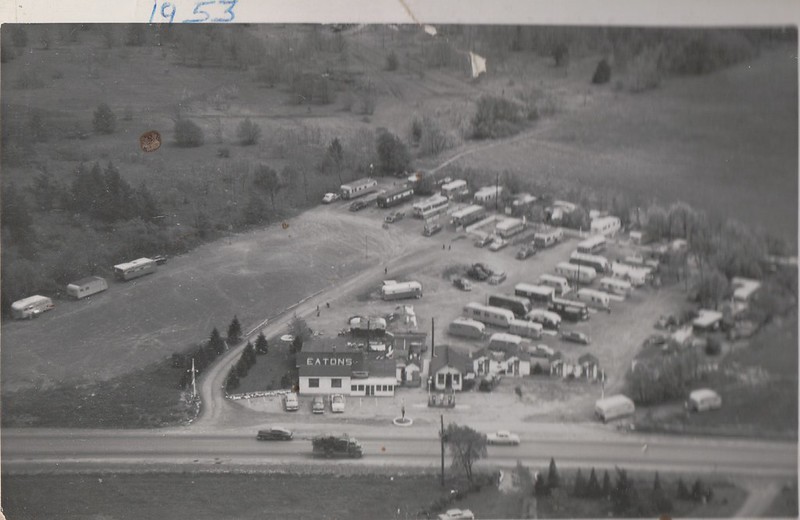
Relics: Farewell to the pay phone booth, at least in NYC
New York City removed its last public payphone from service.
Relics: Eddy indicator post (was “fire hydrant”)
I posted the photo below the other day and sent a Flickr link to to firehydrant.org, which accepts photos of fire hydrants.
The fire hydrant is a necessity, not a relic, but this one on the University of Chicago campus near the anatomy building is certainly vintage. I did some poking around and found a website dedicated to the fire hydrant and its history.
The next morning I received this response from firehydrant.org volunteer Jim Q. I wondered where the hose would attach!
That’s an indicator post that controls a valve for an automatic sprinkler system. Indicator posts are used because it would be easy to shut a valve during sprinkler maintenance and then forget to open it. The indicator post eliminates all doubt as it displays OPEN or SHUT.
Interesting photo because I didn’t know the Eddy name was still in use in 1962 for indicator posts. Eddy Valve made fire hydrants. After the company was bought out their fire hydrant design continued and is still sold today by Clow Valve.
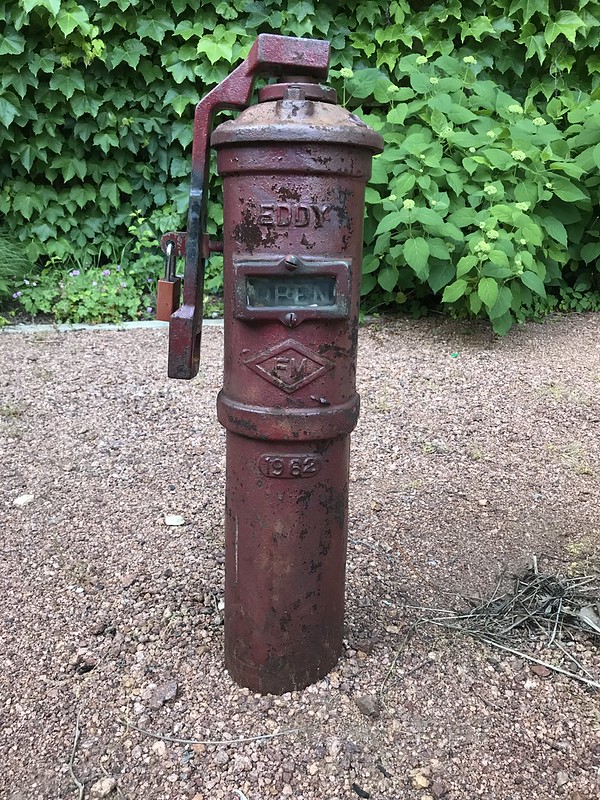
There’s more here about indicator posts.
Farewell to Interstate Inn, Gary, Indiana
While returning from Indiana Dunes today, I looked for the Interstate Inn off the I-90 on ramp. A quick glimpse left me with the impression it was gone. I was not wrong. It was demolished in June.

September 16, 2018

March 10, 2019
There’s some background about the inn at Lost Indiana.
Added July 12, 2020: The sign remains, much worse for the wear of the past two years.

Relics: Newsstand
When I came to Chicago in 1979 (gulp!), you could still find a newsstand here and there. The most prominent, outside the Chicago Cultural Center at Michigan Avenue and Randolph Street, was the first and last thing commuters saw at street level as they left and returned to the Illinois Central Railroad’s Randolph Street Station — the perfect place to pick up a paper or magazine for the train ride home.
According to the Chicago Tribune, the newsstand predated the 1929 stock market crash. At one point it was owned by “King of the Newsstands” Robert Katzman, a fellow Hyde Parker who also owned a busy newsstand at 53rd Street and Lake Park Avenue.
Richard J. Daley, “da Mare,” didn’t like newsstands, claiming many (most?) were dilapidated and didn’t fit in with his beautification plans for Chicago. It also sounds like he may have had the support of one particularly vocal citizen obsessed with getting rid of newsstands. In the end, like Meigs Field, they had to be destroyed.
By then, the newsstand at Randolph and Michigan, Rick’s News, was owned by Rick Graff, who’d bought it in 1984 when he would have been about 22 years old. (That makes Graff one year younger than me — and here I would have thought a newsstand owner would have been some crochety older man, the street equivalent of Mike Royko.) It’s hard to conceive of a young man investing in a newsstand in the 1980s.
From the Chicago Tribune, dated June 12, 1992 (when I would have been 30):
There are about 355 newsstands in the city. The city put final notices to apply for permits on 155 of the stands, and 85 of them did not respond. Those 85 are to be demolished.
. . .
Although the city began its work on the South Side, the most publicized case involves Rick’s News, on the corner of Randolph Street and Michigan Avenue, in front of the Chicago Public Library’s Cultural Center. Rick`s, which is owned by Rick Graff, is not one of the first 85 targeted, but the stand is expected to be demolished.A newsstand has been at the corner for the past 80 years, but General Services Commissioner Benjamin Reyes and other Daley officials have made it clear that they want it removed.
Also from the Chicago Tribune, dated May 23, 1994:
OK. So City Hall won.
And Richard Graff, owner of the oddly charming newsstand on Randolph Street outside the Chicago Cultural Center, lost.
The long-running legal fight between Graff and Mayor Richard Daley’s administration ended when the U.S. Supreme Court refused on May 16 to hear Graff’s appeal of a lower court ruling that the city can force him to close his business.
Never mind that a newsstand has been at that location on Randolph for at least 70 years. Never mind that Graff paid $50,000 to buy the business in 1984. Never mind that he has a steady clientele for his magazines and comic books, not to mention dozens of passersby who pat his friendly Alaskan malamute-the one usually found wearing sunglasses.
. . .
Even people who have never spent a dime there can see that it is an eccentric little piece of a wonderfully eccentric city. Rick’s News belongs in that spot.
Finally, from June 13, 1994:
Crews tore down the stand Sunday afternoon, marking the last chapter in a four-year legal battle between the city and newsstand owner Richard Graff, 32.
. . .“Do you believe it?” a passer-by muttered as he stared at the spot Rick’s no longer occupied. “This was a landmark.”
For 26 years, people new to Chicago have never browsed Rick’s News or experienced this piece of Chicago’s eccentric history.
Even if you’ve never seen a newsstand in person, you may have spotted them in vintage movies or TV shows, or in movies or TV shows set in the early to mid 1900s. One of my favorites is in the Star Trek: The Next Generation episode, “The Big Goodbye.” Jean-Luc Picard, as his favorite hard-boiled private eye, Dixon Hill, didn’t think to bring money to pay “Mac,” the newsstand vendor. “Mac” says Dix can catch him next time. No wonder newsstands in Chicago were dilapidated! No cash for upkeep!
According to Yelp! there are a few newsstands left, including this highly rated one. It was out of Daley’s reach in Evanston, north of Chicago, and looks more like a store than a newsstand.
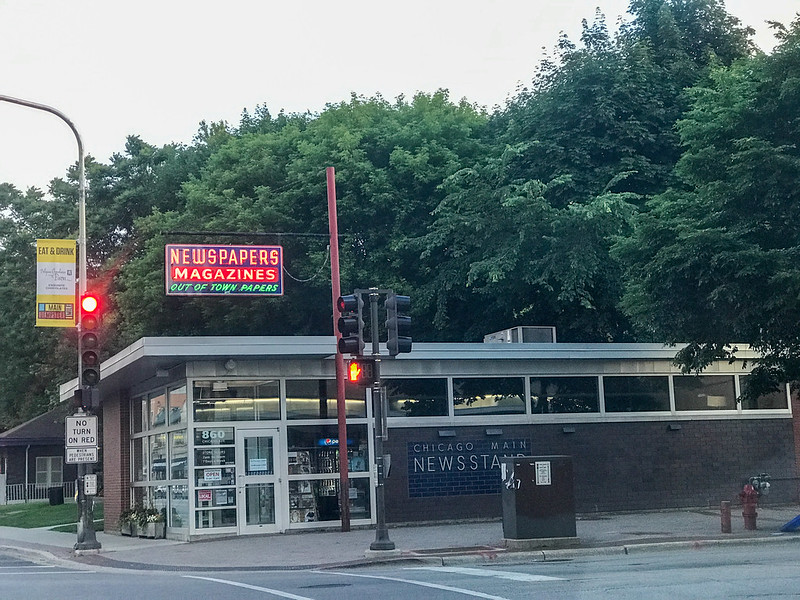
Here’s a review from March 2020:
I wish we could clone Chicago-Main Newsstand and put them all over the US because newsstands like this simply don’t exist anymore. They’re a dime a dozen in Europe but stateside if you want a Financial Times or Italian Vogue you need to subscribe. OR, you could go to Chicago-Main and get just about any magazine your heart could desire. Sports, travel, lifestyle, art, home decor, fashion, auto, literature, wedding, parenting, pet, food, architecture, naked people, crossword puzzles, sudoku, atlases, Chicago history, and a great newspaper selection. Cigarettes, candy, gum, and some greeting cards, too.
I’m glad it’s around. Where else could you get one of those elusive out-of-town papers?
Wee typewriter
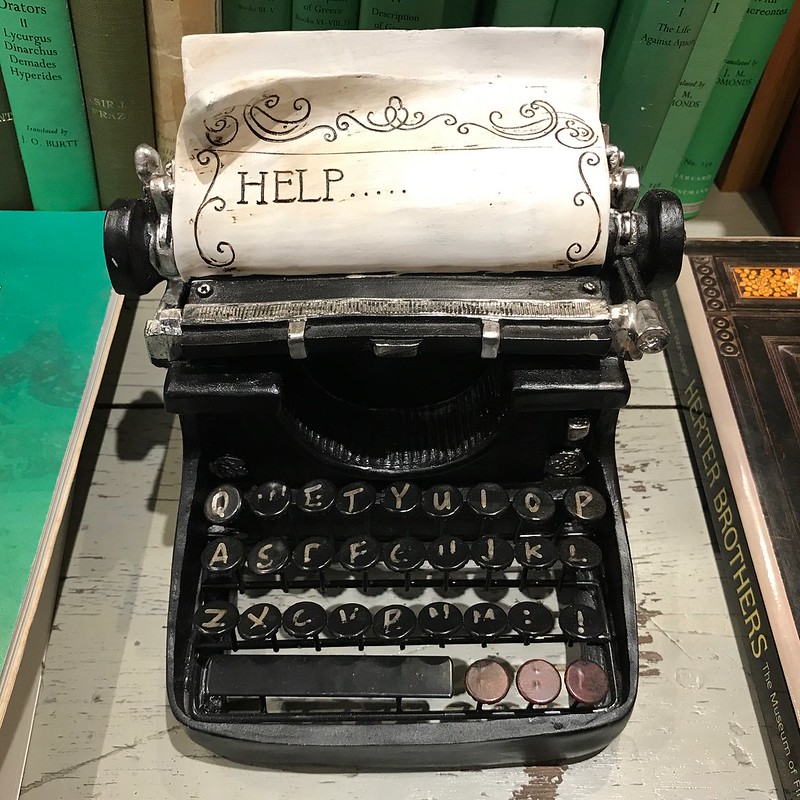
Did someone come out at night and insert the HELP . . . . .?
